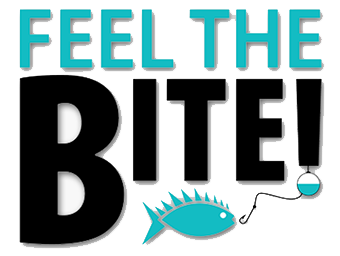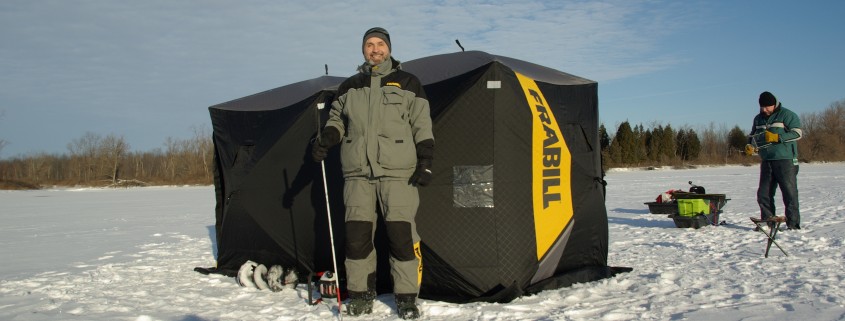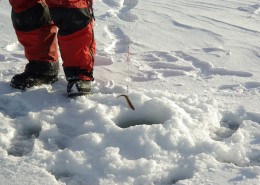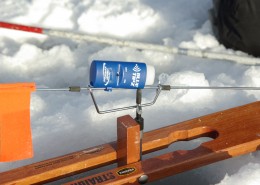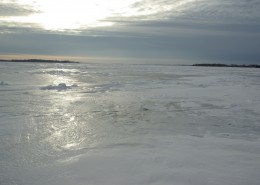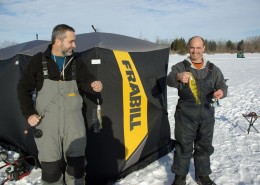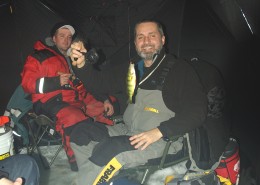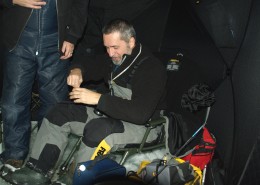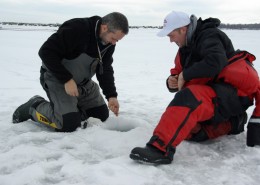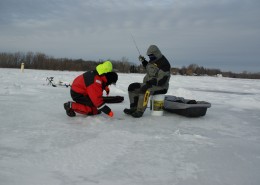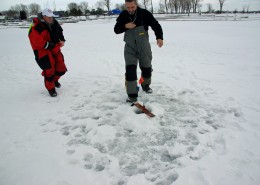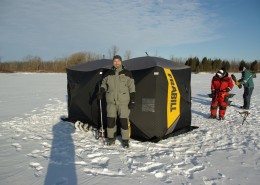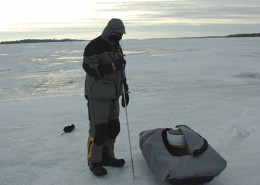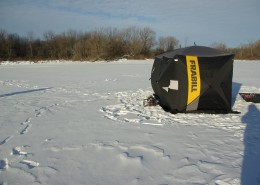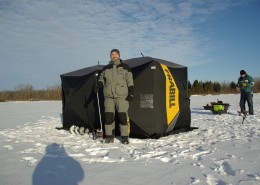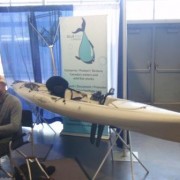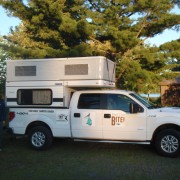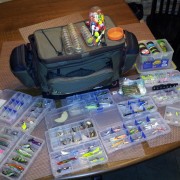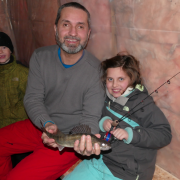Alone or in Groups, the frozen St. Lawrence Offers both
Think about how much water spills over Niagara Falls. Add in a couple dozen more rivers and that will give you an idea of the volume of water flowing down the St. Lawrence River. Now, ask yourself if you would ever consider ice fishing on the Niagara? The answers probably no, but guide Todd Beckstead has made it his business to safely take ice anglers out on to the frozen St. Lawrence.
Whether you prefer your water soft or hard, there’s no shortage of opportunity to catch all manner of species on the St. Lawrence River. How the day unfolds can be just as interesting, including opportunities for fishing together with your friends for jumbo Perch, spreading out to jig over fast moving deep water for monster Walleye, and everything in between. Known for its excellent Large-mouth, Small-mouth, Pike, Walleye, Musky, catfish and Carp, the St. Lawrence River from the Thousand Islands on east to Montreal has been producing record sizes and numbers of fish for decades.
The river was expanded when the St. Lawrence Seaway was developed in the 1960s that saw the installation of a series of dams and locks to facilitate the passage of large ocean-going ships. This deepening and broadening of the river has resulted in its now possessing dual personalities. There’s the fast-flowing current along its deep channel that ranges from 10 to well over 50 meters in depth, and then there are the numerous broad flats hosting a mix of sandy bottoms and weed beds complete with shoals that extend from land for hundreds of meters. Throw in a network of submerged roadbeds and building foundations, and it all adds up to wide-ranging habitat supporting an even greater variety of aquatic life. While it’s true many of the animals that call the St. Lawrence home are relatively new-comers, (invasive), thanks to tougher environmental regulations and a significant reduction in industrial activities along its shorelines, the native species are managing a comeback. The escalating quality of fishing has not gone unnoticed as made evident by the increasing number of local, national and international fishing competitions now staged annually along both its Canadian and U.S. banks.
We caught up with Todd Beckstead exchanging news with the owners at “Bite Me Bait and Tackle” in Morrisburg. While the store may be a relative new-comer, this well stocked fishing store offers a surprisingly wide range of equipment and bait. Todd is intimately connected to the pulse of the St. Lawrence, and while his passion may be fishing, his three-part guiding philosophy is founded on ensuring clients are safe and secure, everyone is having a good time, and fish are being caught.
The bulk of our day was spent fishing for jumbo Yellow Perch. This is the type of fishing that actually gets better the closer you fish together. With four of us comfortably arranged in a Frabill Thermal Headquarters 4-6 person pop-up shelter and four good-sized holes drilled, it wasn’t long before Todd had called over the first Perch of the day.
Fish whisperer is one term that could easily be applied to Todd. Nothing humans can hear above the ice, but made startlingly evident time-and-time-again as Todd dropped down a large five cm long rattle bait to attract the Perch. Within seconds no fewer than six Perch would be clustered around the bait five-meters below taking turns launching attacks on this unknown potential food source. Having triggered their feeding instinct, Todd would quickly retrieve the bait resulting in the Perch dispersing to seek alternatives. The rest of us would simply twitch and hold still small offerings of two cm long minnows or live maggots on size 12 1/32 oz. jigs. Within seconds of the dinner bell’s ringing coming to an end, double and often triple headers would result.
Thanks to countless Zebra Mussels the water of the St. Lawrence is almost crystal clear making it easy to witness directly the different ways Perch strike. Some Perch choose just to watch, while others cautiously taste the minnow or maggot to satisfy their curiosity. And then there are those who rush in to slam your bait. Twitching is usually all that’s needed to trigger the strike, but occasionally letting the bait rest on bottom does the job.
Sonar and colour video displays are not essential kit. Use shorter rods and seating that keeps you positioned erect so you can easily observe what’s taking place through the hole at your feet. The dark interior of the Frabill and the natural light that was penetrating the surrounding 20 cm of solid ice made viewing the scene below almost magical. The way our four 10” holes were positioned, it also made it possible to observe the action taking place beneath your neighbours. Real life gaming with four players – doesn’t get better than that!
Perch seem to roam ceaselessly. Whether to stay warm or two seek out schools of silver shiners and Big Eye that make up their regional diet, one need not wait long for perch to appear below. Prolonged spells of extreme cold will slow down their metabolism and activity levels; conversely, a stretch of milder weather will trigger intense action.
Marauding Pike weighing upwards of 10 kilos can quickly send Perch fleeing for the shelter of near-by weeds. That’s when you hope the large 20 cm long Sucker minnows rigged on tip-ups come into play. Placed well away from our Frabill shelter, the tip-ups provided a welcome break from sitting hunched over holes.
My BlueTipz Bluetooth wireless strike indicator worked flawlessly in alerting me to incursions from Pike. A small light-weight transmitter clipped to the flag of my Frabill XX tip-up instantly triggers an app on my smartphone to notify me that the flag is up. The warning will sound for a minute before turning off and automatically re-setting.
Twice I was sent scrambling. The first time my sucker was relatively unharmed but Pikeless. A bleeding wound to the Sucker’s back resulted in a scent trail. Less than 30 minutes later I was back running for my tip-up and hand-lining around 30 meters of line. Two good runs later I lost the brute at the hole. We did manage to make visual contact with the Northern just as she spat the sucker though, and Todd estimated its size at between three to four kilos. Good fun never-the-less and what I like to think of as a quick-and-easy hook release at the hole. More importantly however, is the lack of a visual photographic record that would have otherwise prevented me from expanding on this particular epic battle in future.
A second quick release scenario I managed to execute in broad view of my fishing companions was a sizable catfish that shook off and slid back down the hole. Todd came close to attempting a recapture by hand, but thought twice given the kitty’s stingers that would have no doubt found flesh. I’m guessing that after the Pike incident, he was on to my ways and wanted to ensure that this time there was a photographic record.
Lots of Perch and a few monsters to boot. Good times were had by all as we hunkered down and enjoyed the warmth of the roomy insulated shelter made toasty with two small heaters in spite of the sunless, frosty and breezy conditions. However, 3: p.m. came and it was time to pack up and prepare for round two of this two-part day.
Everything went back into the trucks, and out came several tiny sleds, a couple buckets, minimal tackle, rods and a manual auger for round two. We headed out by foot beyond the bay and on to the recently frozen main channel of the St. Lawrence to try our hand at intercepting a school or two of monster Walleye as they executed their evening patrol.
The ice was crystal clear making it possible to look straight through and see perfectly the depth and bottom structure below. After positioning ourselves using a series of complex geometric calculations, as well as the conveniently placed marker buoys, we drilled our holes in the 15 or so centimeters of clear ice.
We brought with us no shelters to protect ourselves from the 30-kph winds out of the east as erecting and anchoring anything on the glare ice would have taken about as long to accomplish as we intended to stay. The evening bite here lasts about 90 minutes, and is attempted over 15 meters of water in a five kph current.
Offerings that are a minimum of ½ oz. in weight are essential to execute a vertical presentation. Multiple hooks and numerous smaller minnows are recommended to avoid having to reel up and re-bait during a very short window of opportunity. If they manage to get one of your minnows, you know you still got a few more down there to work with.
Fishing together in a single shelter is also not an option due to the current’s effect on the lines and the size of fish being pursued. It’s imperative to spread out to avoid tangles that could easily end everyone’s chance to ice trophy Walleyes.
Keeping our back to the wind was the only way of preventing frostbite to our face and hands. Todd cautioned however, that the instant that contact was made with a fish we move to the up-stream side of the hole to allow the easterly current of the St. Lawrence to do the work of tiring the Walleye and to facilitate fish extraction through the ice. Walleye here can range upwards of eight kilos.
“Winds from the east, fish bite least”, was our undoing that day. The minus 35 degree wind chill made things slightly uncomfortable and may have influenced our decision to head back to shore fishless slightly before 5:30 p.m. — the end to our window of opportunity. After a day of non-stop fish captures, a punishingly cold fishless couple hours out in the open wasn’t the end of the world. It does however; make me anxious to return to the River to finish what I started. Caution will be taken however, as the Fast moving water like the main channel of the St. Lawrence isn’t somewhere I would want to venture without the expertise of a seasoned guide. Wouldn’t want my fishing trip of a lifetime to turn into the last trip of my life.
To get a hold of Todd Beckstead to arrange your own adventure, try the following:
Tel: 613-643-2067 or toddbbeckstead@hotmail.com.
